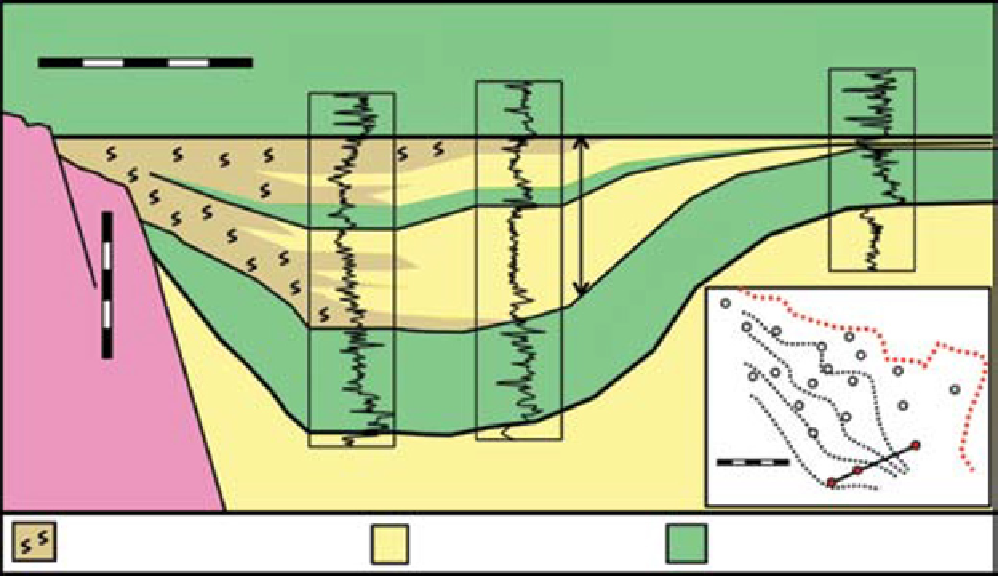Geoscience Reference
In-Depth Information
NE
SW
30/16-A30
GR
30/16-A31
GR
500m
30/16-A36
GR
Datum Top Ribble Sands
50 m
15
BCU
30
45
60
AUK HORST
Mersey
Sandstone
Member
A30
A31
1 km
A36
Facies T5 Bioturbated silty sandstone
Facies T4 Massive sandstone
Facies T3/T2/T1 Heterolithic/shale
Fig. 21.
Rapid lateral facies changes in the Ribble Sandstone Member (adapted after Robinson, 1990). Facies are described
in more detail in the text. Inset map shows the location of wells and the thickness of the unit with contours in metres. BCU:
Base Cretaceous Unconformity; GR: Gamma Ray log.
earliest studies of the Ribble Sandstone Member
recognised a turbidite origin for these deposits
which were said to form discrete lobes or sheets
(Robinson, 1990) within the Kimmeridge Formation
shale. Stockbridge & Gray (1991) describe the
Ribble Sandstone Member as several distinct
sandstones, all of which thin and pinch out
towards the crest of the structure. It has been
postulated that the Ribble Sandstone Member
might have been derived from the erosion of
the Auk Horst (Clelland
et al
., 1993; Robinson,
1990). Subsequent study by Kuhn
et al
. (2003)
has suggested a derivation of the Ribble Member
turbidites either from adjacent shoreface sand-
stones or from an unknown source to the north-
west. A depositional direction towards the
south-east is shown (fig. 10 of Kuhn
et al
., 2003)
with the depositional transport direction being
influenced by active palaeofaults with a NW-SE
strike trend.
The same study indicates that the Ribble
Sandstone Member comprises an interfingering of
well bioturbated distal shoreface deposits and tur-
biditic units. Kuhn
et al
. (2003) made a study of the
stratigraphy of the Fulmar Field (Fig. 20) and state
that it is “difficult to resolve the close intercalation
of the Ribble shoreface facies with the deeper
marine turbidites”. This same problem was exam-
ined at length by Robinson (1990) who proposed
four different models to explain the relatively rapid
facies change from massive turbidite sandstone
(Facies T4, as previously described) and biotur-
bated silty sandstone (Facies T5, interpreted as
shallow shelf silty sandstone) over an interval of
380 m (Fig. 21). These models are: (1) Facies T5
forms on a local structural high adjacent to a deeper
water trough where turbidite Facies T4 and T3
accumulate; (2) Facies T4 infills a channel cut into
Facies T5; (3) Facies T5 are levee overbank deposits
developed laterally to turbidite sandstone channel
Facies T4 and Facies T3, or (4) a salt ridge formed
an intraslope basin where Facies T5 accumulated.
There is a basic assumption in all these models that
the sand grade sediment that comprises the Ribble
Sandstone Member is sourced from the Auk Horst.
Kuhn
et al
. (2003) supported the idea of deposition
of Facies T5 on fault-controlled topographical
highs, but also mentioned the possibility that the
Ribble Member could have been sourced by rework-
ing of older Upper Jurassic sandstones.

Search WWH ::

Custom Search